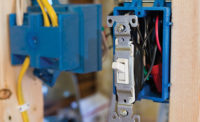Here are the industry sectors that had the most trouble complying with 1910.305, based on total penalties assessed: 1) fabricated metal product manufacturing - $333,800 in penalties; 2) food manufacturing - $214,231; 3) plastics and rubber product manufacturing - $130,430; 4) merchant wholesalers, durable goods - $109,559; 5) support activities for mining - $109,598; 6) transportation equipment manufacturing - $106,521; 7) wood product manufacturing - $104,686; 8) primary metal manufacturing - $95,662; 9) nonmetallic mineral product manufacturing - $80,398; and 10) merchant wholesalers, non-durable goods - $79,056.
The fabricated metal product manufacturing industry had far more citations (308) than the next four most-cited industries – food manufacturing (126); wood product manufacturing (120); merchant wholesalers – durable goods (114); and plastics and rubber products manufacturing (108).
Repair and maintenance services received 97 citations of 1910.305 for penalties totaling $55,131.
Here are a few key requirements of 1910.305:
• 1910.305(a)(1)(i) Metal raceways, cable trays, cable armor, cable sheath, enclosures, frames, fittings, and other metal noncurrent-carrying parts that are to serve as grounding conductors, with or without the use of supplementary equipment grounding conductors, shall be effectively bonded where necessary to ensure electrical continuity and the capacity to conduct safely any fault current likely to be imposed on them. Any nonconductive paint, enamel, or similar coating shall be removed at threads, contact points, and contact surfaces or be connected by means of fittings designed so as to make such removal unnecessary.
• 1910.305(a)(1)(iii) No wiring systems of any type may be installed in ducts used to transport dust, loose stock, or flammable vapors. No wiring system of any type may be installed in any duct used for vapor removal or for ventilation of commercial-type cooking equipment, or in any shaft containing only such ducts.
• 1910.305(a)(2)(i) Temporary electrical power and lighting installations of 600 volts, nominal, or less may be used only as follows:
• 1910.305(a)(2)(i)(A) During and for remodeling, maintenance, or repair of buildings, structures, or equipment, and similar activities;
• 1910.305(a)(2)(i)(B) For a period not to exceed 90 days for Christmas decorative lighting, carnivals, and similar purposes; or
• 1910.305(a)(2)(i)(C) For experimental or development work, and during emergencies.
• 1910.305(a)(2)(ii) Temporary wiring shall be removed immediately upon completion of the project or purpose for which the wiring was installed.
• 1910.305(a)(2)(ix) All lamps for general illumination shall be protected from accidental contact or breakage by a suitable fixture or lampholder with a guard. Brass shell, paper-lined sockets, or other metal-cased sockets may not be used unless the shell is grounded.
• 1910.305(a)(2)(x) Flexible cords and cables shall be protected from accidental damage, as might be caused, for example, by sharp corners, projections, and doorways or other pinch points.
• 1910.305(a)(2)(xi) Cable assemblies and flexible cords and cables shall be supported in place at intervals that ensure that they will be protected from physical damage. Support shall be in the form of staples, cables ties, straps, or similar type fittings installed so as not to cause damage.
The complete standard 1910.305 can be accessed on OSHA’s website at https://www.osha.gov/pls/oshaweb/owadisp.show_document?p_table=STANDARDS&p_id=9882

